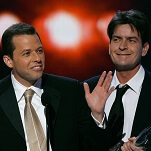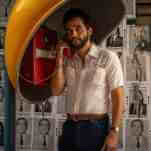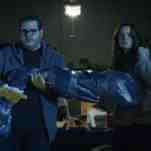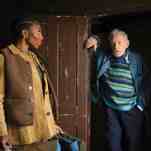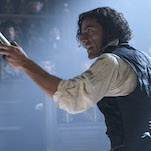Twenty years ago, Canadian cartoonist Chester Brown wrote about the history of his porn collection in The Playboy, a series of comics that first appeared in Brown’s Yummy Fur before being collected in book form. At the time, Brown was just starting to dabble in autobiography, so his art-style in The Playboy wasn’t too far removed from his more surreal, darkly humorous stories. The content may have been less outrageous, but Brown’s explicit close-ups of voluptuous Playmates and his own masturbation rituals gave The Playboy an eerie quality befitting a subject often steeped in shame.
Brown’s latest book, Paying For It (D&Q), is another autobiographical piece, tracking his recent history as a patron of prostitutes. And “tracking” is the right word here. In keeping with the style of Brown’s well-received historical epic Louis Riel, Paying For It takes a detached approach to its subject, telling its story in tiny panels populated by even tinier characters positioned like figurines in a museum case. Brown begins with the moment in 1996 when he broke up with what he calls “my last girlfriend,” and then proceeds through his thought process as he decides that “possessive monogamy” is socially regressive, and that it makes more sense to separate companionship and sex. On March 26, 1999, Brown visited his first incall escort. In Paying For It, Brown details the encounter, and ends by writing, “A burden that I had been carrying since adolescence had disappeared. The burden has never returned.”
The clinical quality of Paying For It can be a little frustrating at times, as Brown meticulously and exhaustingly documents all the prostitutes he’s seen over the years, interspersed with scenes where he argues with his cartoonist pals Seth and Joe Matt about the righteousness of his new attitude about sex. (The book also includes 50 pages of appendices and endnotes, filled with citations both for and against sex work, intended to defuse concerns about human trafficking, drugs, disease, and exploitation.) Whenever Brown crosses over from “This is an arrangement that works for me” to “This is the way everyone should live,” Paying For It becomes… well, strange.
But Brown’s subject is inherently fascinating—who’s not a little curious about other people’s sex lives?—and his cartooning skills are as sharp as ever. Even working at a remove, Brown still finds the humor and the drama in his “dates.” Some are a little dangerous; some are laughably bad. Paying For It even has a late twist that calls into question a lot of what Brown’s trying to say about whether the traditional romantic order is corrupt. Does Brown mean to undercut himself? Probably not, given the barrage of documentation that ends the book. But the advantage of Brown’s “watching from a distance” style is that it’s open to interpretation, allowing readers to re-raise the questions that Brown may think he’s answered.
Wilfred Santiago’s book
“21”: The Story Of Roberto Clemente (Fantagraphics) couldn’t be more different from
Paying For It, even though it’s also non-fiction. Exuberantly expressive where Chester Brown is doggedly minimalist, Santiago imbues his biography of famed Puerto Rican baseballer Roberto Clemente with the furious energy of a Clemente triple. After a brief intro, set on the day that Clemente got his 3,000th major league hit,
“21” moves chronologically—but that’s about its only concession to conventional biography. Santiago deals mainly in moods and moments, dwelling on Clemente’s early life in a Puerto Rico divided over its allegiances to the United States, and how he went on to deal with racism, segregation, and the negative perceptions of the press.
Baseball fans may be disappointed that “21” isn’t as comprehensive as it could be about Clemente’s career as a Pittsburgh Pirate, or about what he meant to Latin Americans then and now. But what the book lacks in hard information, it makes up for in style. Santiago evokes the world Clemente lived in, from the dusty Puerto Rican streets where he played baseball with bottle caps and tree branches to his years as a perennial All-Star. The art is scratchy and abstract when it’s dealing with home and homesickness, and then hardens into the stuff of superhero comics whenever Clemente steps to the plate.
Howard Cruse’s
The Complete Wendel (Universe) splits the difference, content-wise and style-wise, between Chester Brown and Wilfred Santiago. Collecting comic strips Cruse drew for
The Advocate between 1983 and 1989,
The Complete Wendel is both a from-the-front-lines journal of gay life in the turbulent ’80s and a still-relevant effort to normalize the outré. A stalwart of the underground comix movement even before he came out, Cruse has always adhered to the original underground’s fusion of the cutely cartoony and the unsettlingly surreal. His
Wendel strip was more grounded than some of his earlier work, but because Cruse’s characters aren’t above a little decadence,
Wendel can slip easily from everyday domestic and workplace comedy to drug reveries and nightclub orgies.
Because his work keeps falling out of print—and because he hasn’t been as prolific as other alternative cartoonists—Cruse has rarely gotten his due as one of his generation’s most appealing and inventive artists, or as one of the medium’s best storytellers. The Complete Wendel follows the lives of around a dozen characters, grouped around chipper young writer Wendel Trupstock and his thespian boyfriend Ollie Chalmers. The first couple of years of the strip mainly deal with Wendel and Ollie getting to know each other in sweet, largely plotless vignettes. Cruse took a year off when The Advocate re-formatted in 1985, and when he returned, he tightened Wendel up, making it into more of a serial, with lengthy stories and cliffhangers. The strip also became more overtly political. When Wendel began, Cruse gently mocked the in-fighting and rigid idealism of queer activism. Then AIDS ravaged the gay community, and Wendel started to seethe.
Still, while The Complete Wendel is a useful document of what Cruse and his friends were going through nearly 30 years ago, it’s just as remarkable for how contemporary it feels. Cruse could wax poetic about the kinky side of gay life, as when Ollie visits a bathhouse and sighs, “There’s something so primally serene about standing in a pitch-black room full of anonymous hunks and waiting for your pupils to dilate.” But Wendel is more often about Wendel and Ollie dealing with the ordinary trials of life that any other committed couple faces—including raising Ollie’s son from a previous marriage. That depiction of an “alternative lifestyle” as warm, fuzzy, and mainstream seemed fairly radical at the time; now, as it always should’ve been, it just seems natural.
Also…
Both Dan Clowes’ Mister Wonderful (Pantheon) and Pascal Girard’s Reunion (D&Q) are about men psyching themselves up for what they hope will be an important night, though aside from a similar premise, the books don’t have much in common. Reunion reads like a sketchbook diary, detailing Girard’s efforts to get in shape in time for his 10-year high-school reunion. Everything that can go wrong does: Girard develops an unsightly wart; he fails to follow the instructions on the invitation; and his attempts to make himself look cool in front of his old crushes end up backfiring. Reunion is funny and relatable, even if its ultimate point—that we can’t control how we’re remembered—is a bit slight for a 150-page book. Mister Wonderful, meanwhile, is something of a revelation, coming from Clowes. Modified and expanded from a series of strips that ran in The New York Times Magazine a few years ago, Mister Wonderful takes place over the course of one long night as a nebbishy divorcé frets his way through a blind date that starts out promising and then takes a few unfortunate turns. Unlike Clowes’ bleak (albeit hilarious) Wilson, Mister Wonderful is surprisingly sweet, using the basic form of an indie romantic comedy to lead the reader through the thought processes of a levelheaded but lonely middle-aged man. It’s like a long-form version of some of the semi-autobiographical stories Clowes used to do in Eightball, where the petty annoyances of modern life—pushy panhandlers, ill-timed cell-phone calls, entitled assholes—push an ordinary guy to rave like a lunatic. …
The debasement of the term “graphic novel” continues apace with Happiness Is A Warm Blanket, Charlie Brown! (Kaboom!), a painfully sloppy tie-in book to a recent Peanuts TV special. Taking some of the original Charles M. Schulz strips that inspired the special—all about Linus’ efforts to secure his blanket from the dogs, sisters, and grandmas who want to seize it—Happiness Is A Warm Blanket re-arranges the panels into conventional comic book pages, with additional artwork to make them look more graphic-novel-y. The results steamroll Schulz’s pacing and comic timing, and don’t add up to much of a story, either. (It’s disappointing that a cartoonist as reliable as Pearls Before Swine’s Stephan Pastis was involved with this project.) All those exposed to Happiness Is A Warm Blanket should immediately cleanse their palates with The Complete Peanuts: 1979 To 1980 (Fantagraphics), which features a touching intro by Al Roker—who conducted the one of the last interviews with Schulz—along with two years’ worth of strips that find Schulz still going strong as a documentarian of life’s simple pleasures and overwhelming anxieties. …
Jacques Tardi’s 1972 graphic novella The Arctic Marauder (Fantagraphics)—adapted from characters created by surrealist/pulp novelist Léo Malet—is a fine example of the French artist’s early work, which combines turn-of-the-century adventure stories with deadpan zaniness. It’s recommended for those who like submarines disguised as icebergs, world-domination plots, detailed schematics of bizarre inventions, heroic dowagers, and sudden reversals, as well as for those who’d like to see all of the above rendered in Tardi’s typically detailed linework, which looks amazing even when obscured by ice and snow. …
David Lester’s sprawling, at times baffling The Listener (Arbeiter Ring) considers the responsibility of art to depict what’s really happening in the world, by contrasting the story of Hitler’s rise to power in the ’30s with one modern artist’s trip to Europe. Lester has a hard time cobbling this material into a clear narrative—the book’s more like page after page of ideas, dispatched in a rush—but there’s a thematic depth and sense of ambition to The Listener that’s admirable. As Lester’s heroine tours museums and contemplates how art often fails to capture real atrocity, The Listener’s intellectual approach begins to reflect what it’s about.
